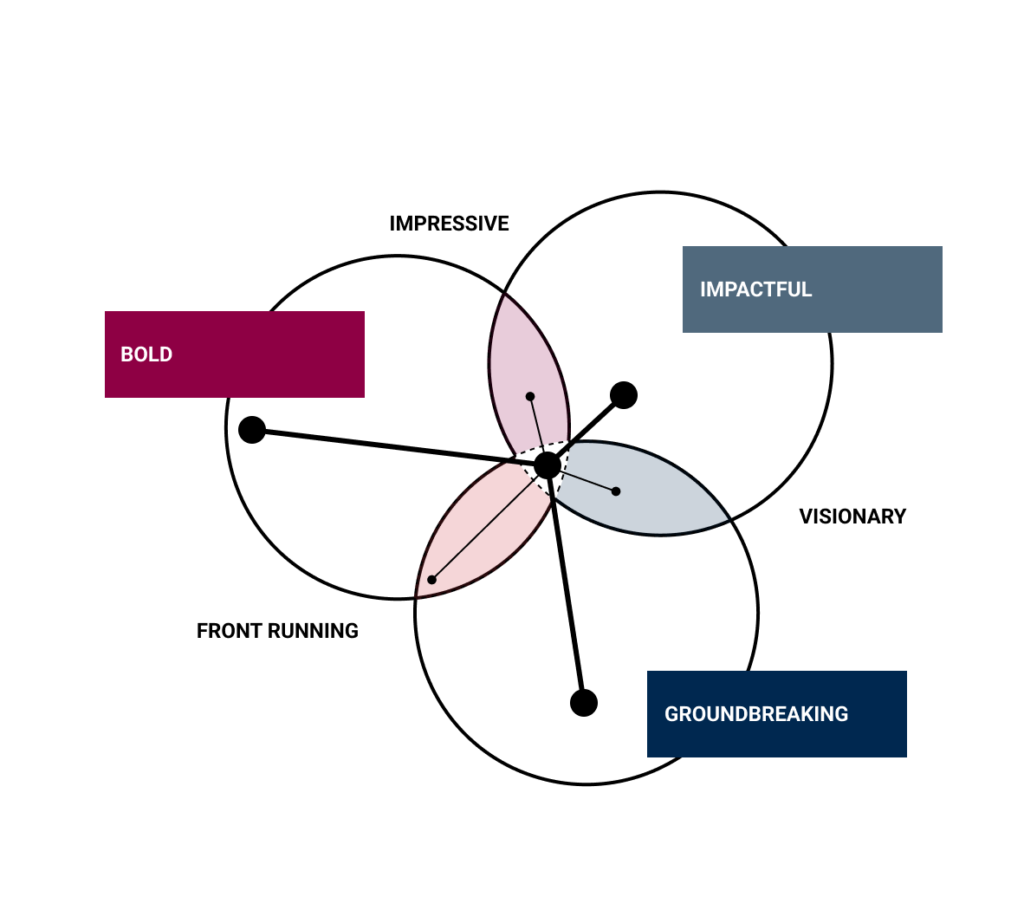Core Values

Core values are traits that represent an individual’s or an organization’s highest priorities, deeply held beliefs, and core, fundamental driving forces.
WHAT IS IT
A strong and effective Value Proposition is composed of three main macroblocks, of equal importance and relevance. You can’t build a solid Value Proposition if one of these blocks is missing or it is ill-formulated, the result will be fragile and difficult to fulfill.

These three main blocks are:
-
The Core Values (CVs)
-
The Promise (P)
-
The Unique Selling Proposition (USP)
We can also define a Value Proposition with a math formula using just initials for shorts:
VP = CVs x P + USP
Core Values
A Value Proposition should be a lighthouse on a stormy night for your customer, but also for your own people: no matter what it should be consistent and, to some extent, coherent.
In order to do so, every organization needs to act in perfect synchronization both in time and in action, which means that no single unit or supplier cannot operate unsupervised without proper governance.
In the field, implementing total control on every aspect, supplier, or unit is unrealistic, therefore an organization should rely on rules and guidelines to drive the choices and actions of individuals.

For standardized tasks where no agency or any degree of freedom is required, an organization should provide regulations, by promoting a so-called “hard determinism”: the output of actions should always be the same, reducing the cost of direct supervision.
- REGULATIONS and Compliance are the best way to enforce strict control and standard results, however, the real world is complex and regulations cannot cover for every specific course of action without resulting in a bureaucracy hell.
- RULES, On a higher level, organizations need to rely on rules, whether or not, any individual in the organization can always know what rules should apply in a given context, there is no degree of freedom, but some grey areas can provide different interpretations of the same rule… and, you know… rules can be broken sometimes.
Since we cannot think and design for everything, rules are not a reliable tool: rules are not made for unexpected events, and they tend to choke free will in favor of predictability (of outcomes and costs, mainly), therefore when something unscripted happens, things may go south very quickly. Imagine a scenario where, due to rules, your people provide a totally avoidable bad service to a customer “just because these are the rules“. To some extent, skilled employees need some degree of agency to act in not standard scenarios, this is where organizations require a more fluid rulebook, such as guidelines, principles, and values.
These three types of implicit code of conduits are still considered a type of governance, but indeed more subject to interpretation:
- GUIDELINES are “strong suggestions”. Usually, it’s not advisable to not follow guidelines, they are best practices, standard de facto, and they need to be considered and treated as implicit rules, most of the time and in very specific occurrences, you may derail from them.
- PRINCIPLES are even higher than guidelines, they are meant to be a direction giving any individual more freedom to act if in accord with a principle. “The Customer is always right” is one infamous principle: no matter what you do, everything is allowed if it’s done accordingly to an organization’s principle.
- VALUES are even higher than principles, they are meant to be an identity choice, an ethos declaration to stand by no matter what. Any organization needs to abide by a set of values, representing both its heritage and its legacy. A value will limit your space of choice on what you can do, say and react, it won’t give your people a higher degree of freedom, but it will give them purpose.
CORE VALUES
Core values are traits or qualities that are not just worthwhile, they represent an individual’s or an organization’s highest priorities, deeply held beliefs, and core, fundamental driving forces. They are the heart of what your organization and its employees stand for in the world
WHY IT IS RELEVANT
With customers today being pickier than ever when it comes to picking their favorite brands, marketers need to create products and campaigns that align with their values. Gen Z and millennials have been shown to be less willing to compromise on their brands’ promises than previous generations, such as making sure the products they buy align with their values. This is due in large part to the abundance of marketing research available today that shows them the effect their purchases have on society and themselves.
It’s up to organizations today to make sure they create quality products that embody these values or risk falling behind competitors who are willing to do so.
Product companies, often rely on traditional brand values, such as Tradition, Authenticity, History, Quality, Hand-Crafted, and so on. Service Companies weigh in with more personal values, such as Security, Personal, Sustainable, close, and more suitable, to a digital context.
Every Value Proposition has a Core Values component in its DNA, and this core can either be a single Value or a set of Values, that customers and your own people, can clearly perceive, feel, and understand.
Values need to be relatable.
For example, the VP of an online banking platform would comprise its core functionalities, pricing structure, customer experience, etc. but, in general, value propositions are expressed using words such as “better”, “fastest”, “cheaper”, “faster”, “easier”, “simpler”, “innovative”, etc.
Core Values System

Not all Values should be equally important for your organization. A Core Value System is a hierarchy where all Values are divided by importance, relevance and priority:
Primary Values are the most prioritized and important since they are the foundation of your business and they are also the ones you strategically decide to bet on in your strategic plan. Part of the process is about defining what values are primaries and what are secondaries and tertiaries.
Between all values not only a hierarchy can be established, but also dependency relationships where a Value cannot exist regardless of its surrounding (eg: you cannot be “sustainable” if you are not also “green“) or derivative relationships (eg: “fast” is a derivative of “reactive” at a perception level).
In Summary
The core values of a brand are the most basic and enduring beliefs of an organization. They can be understood as qualities or characteristics that truly drive organizations to achieve their mission and vision, creating a blueprint for how things should be done.
With a strong and well-articulated set of values, an organization can transform from being a simple business to something much larger and more meaningful.
USE IT FOR
Being consistent with your actions and messages to your audience.
Every strategic choice and every action should be consistent with your Core Values so that your customers can recognize your distinctive traits across all channels and offerings.
Another take is about playing with core values not externally, but internally, to your own people. By aligning core values for your customer and making them relatable to your corporate values, organizations can create a silver lining of motivation and purpose for their employees.
Corporate values are the core and underlying philosophies that guide a company and its people. These beliefs also affect how a company interacts with partners, customers, and shareholders. A company’s culture must align with its core values in order to create a shared, lasting and positive environment for all of these parts.
Once you’ve established your values, you need to incorporate them into every aspect of your organization’s culture. And one of the best ways to build a culture that aligns with your company’s values is to recognize the employees who embody them.
REQUIREMENTS
-
Key People
Gather key people accountable for deciding the vision according to the scope. C-Levels are required to decide values that will set the course of the organization for the next strategic plan, D-Levels and Managers are required if the scope level is bound to a business line, Managers and Produt Owners if values refer to a product.
-
A Workshop Space
To define Core Values, a workshop or a brainstorming session works best. Be sure to have a large table or a big wall as a working canvas to work respectvely with cards or post-its.
-
External Data and POVs
Bring at the discussion external points of view from outside your organization, such as competitor analysis, survey, and other researches. External data can be used to inpire, inform or even challenge internal belief and avoid hindsights.
STEP BY STEP
Defining your company’s values requires careful consideration of your organization’s culture and vision. Think deeply about how to use your values to illustrate what your company hopes to achieve and represent. Consider these guidelines when establishing your company’s values:
-
List all the Values that can be applied to your brand
Think about all positive attributes and values your brand should communicate to describe itself. If the list counts more than ten items, try to identiify a minimum common shared set, discarding all items that cannot be applied to all your offerings.
-
Gather views from outside
Brainstorm with the team: gather your team and ask them to write down the top five values that represent your brand/organization. You can also ask open-ended questions like: "What do we value most as a brand/organization?" "What does our brand represent?" "What is our identity?"
Survey: Survey your clients, customer or even partners to understand how they see you, quick and spot on questions should suffice, it's not a brand research. -
Analyze the competition space
Try to identify whether or not your direct competitors are operating according to established values. Is there anything they are doing that offers you an opportunity or space to establish a more dominant set of values?
-
Order all items by priority
Take all your items, order them from the top using a priority or an importance criteria: the more suitable, fittable, justified for you. Words have meaning, don't force a categorization or clustering of terms if nuances are important.
-
Narrow Down Core Values
Take the first five items from the top from the list and discuss with your peers. Narrow down the total number of values to a set of 3 to 5 items, these are interesting candidates for your Core Values, since they are the most relevant and the most recognizable for your brand or organization. This will help you stay focused and more precise in your strategy.
-
Create Hierarchy and Relationships
Once you created a global vision of your values ecosystem it's time to build a hierarchy. Identify fil-rouge between values in order to highlight relationships, hierarchies and causations.
Repeat the same process with the remining items from the list to identify secondary and tertiary values.Secondary and tertiary values are important to your strategy, however they may be not so relevant for your customer because they may be too obvious or common on the market to make you stand out from the crowd. -
Distill principles
Distill 1-2 guiding principles per each relevant value cluster. This will help you stay consistent and ensure the brand values are well implemented across your business.
PLAY WITH EXAMPLES
KELLOGG'S
- Integrity
- Accountability
- Passion
- Humility
- Simplicity
- Results
PATAGONIA
- Build the best product
- Cause no harm
- Use business to protect nature
- Not bound by convention
SALESFORCE
- Trust
- Customer Success
- Innovation
- Equality
OLYMPUS
- Unity
- Integrity
- Empathy
- Long-Term View
- Agility
ADIDAS
- Performance
- Passion
- Integrity
- Diversity
BEN & JERRY'S
- Human rights and dignity
- Social and economic justice
- Environmental protection, restoration, and regeneration
STARBUCKS
- Creating a culture of warmth
- Acting with courage
- Being present
- Delivering our very best
- Being performance-driven
NIKE
- Inspiration
- Innovation
- Authentic
- Connected
- Distinctive
TESLA
- Doing the best
- Taking risks
- Respect
- Costant Learning
- environmental consciousness
BURGER KING
- Teamwork
- Family
- Excellence
- Respect
LEGO
- Fun
- Creativity
- Imagination
- Learning
- Caring
- Quality
WORKS WITH
Our model for defining and representing Core Values is called Triple Constraint, it’s a model we developed specifically to help companies make order in their priorities while building a Core Values System for their Value Proposition.






